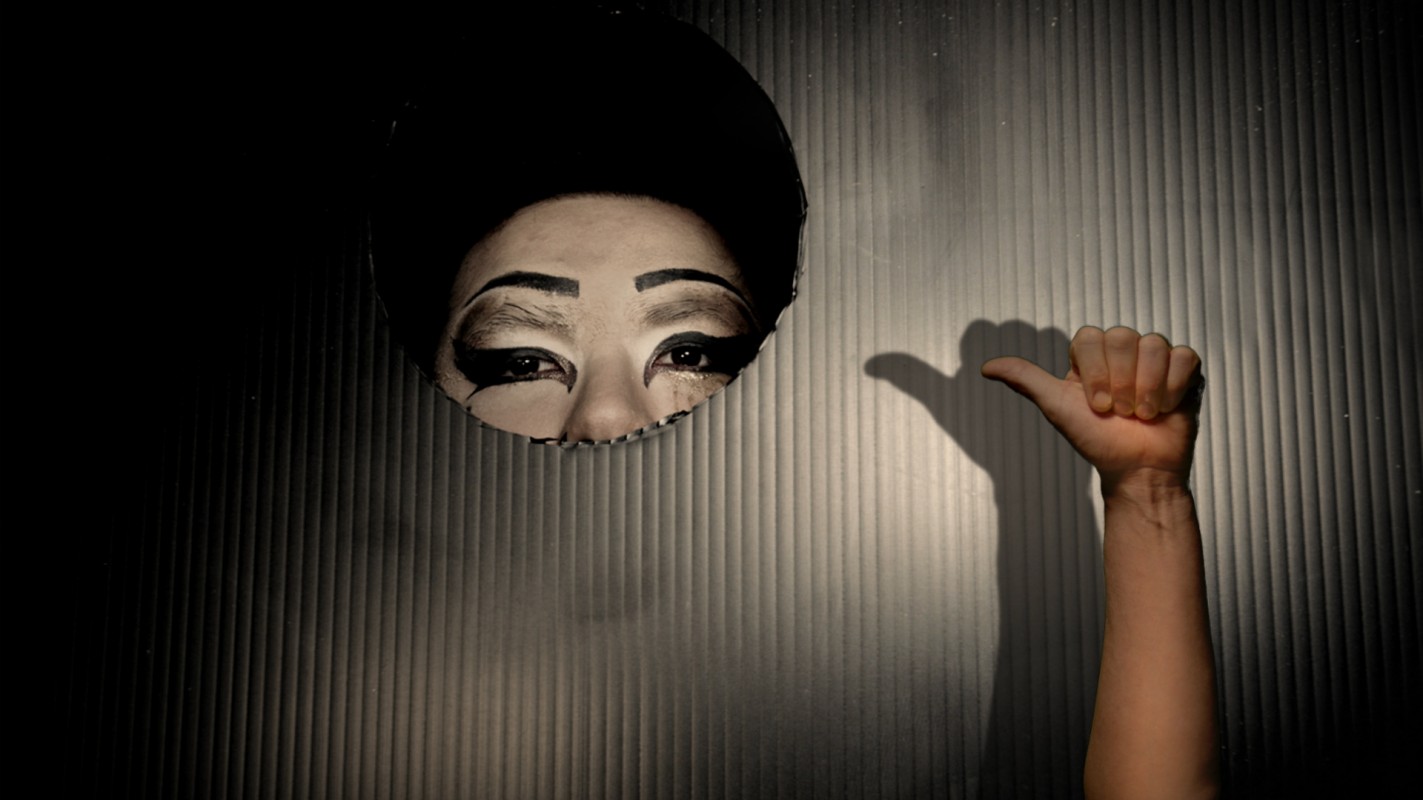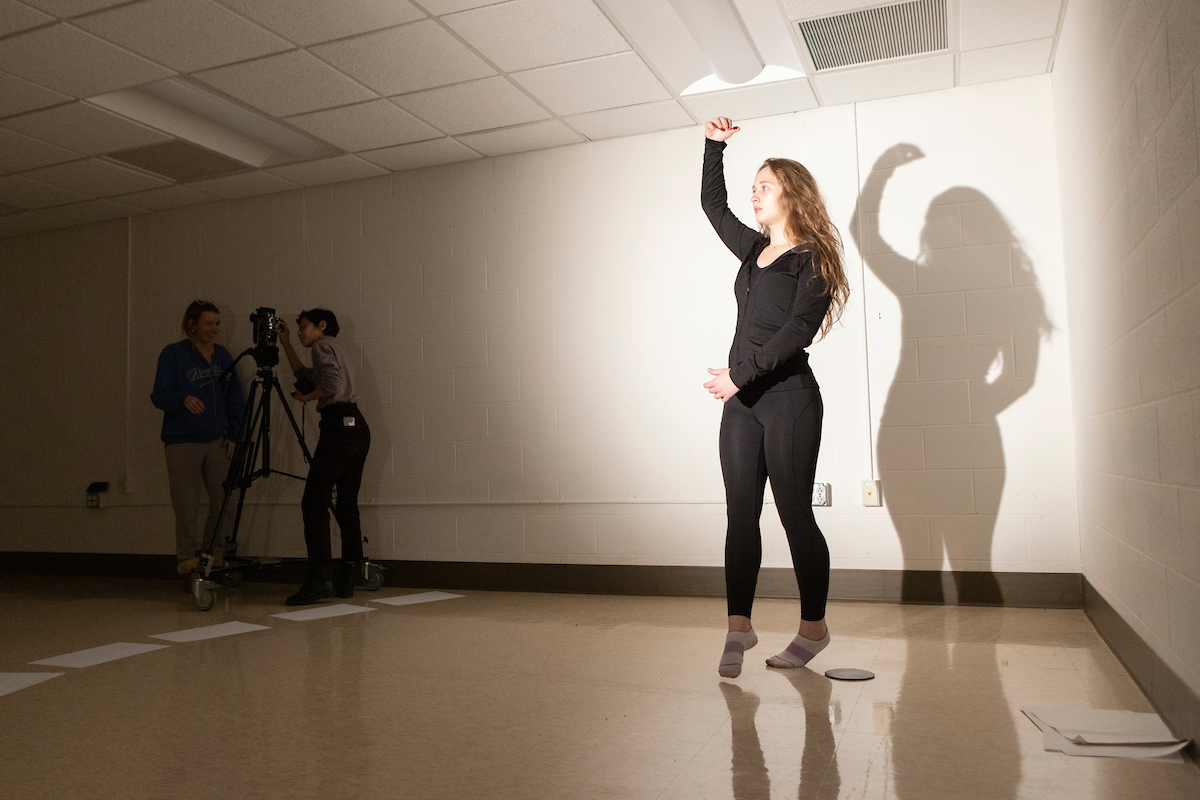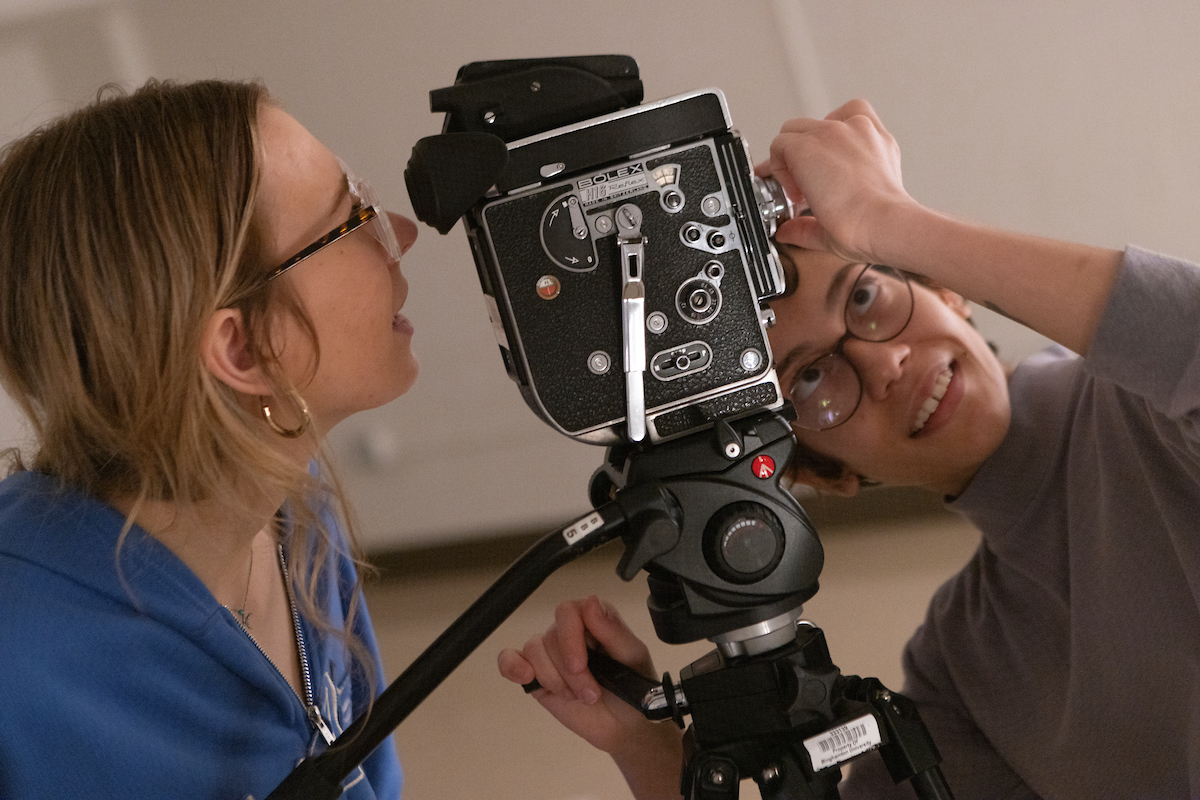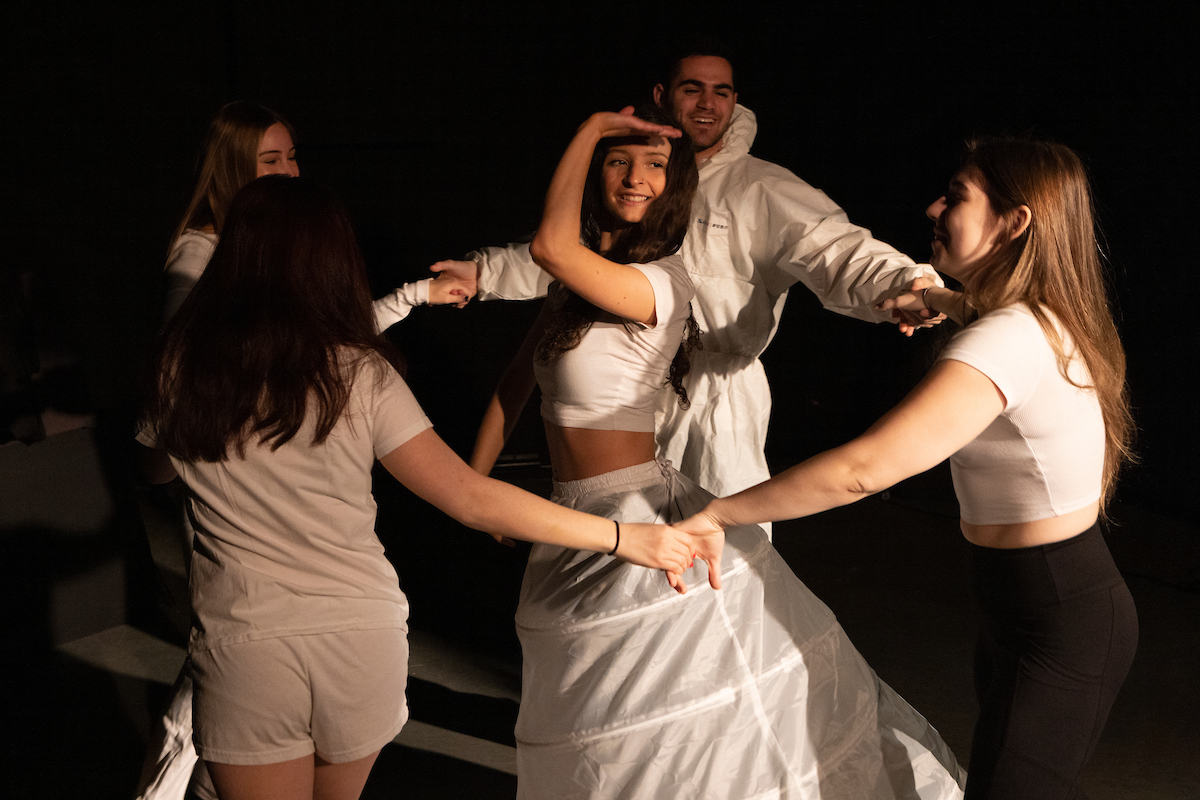Ballet Mécanique: Dance, music and cinema classes pool their inspiration
Four classes will present their avant-garde compositions to the public May 5
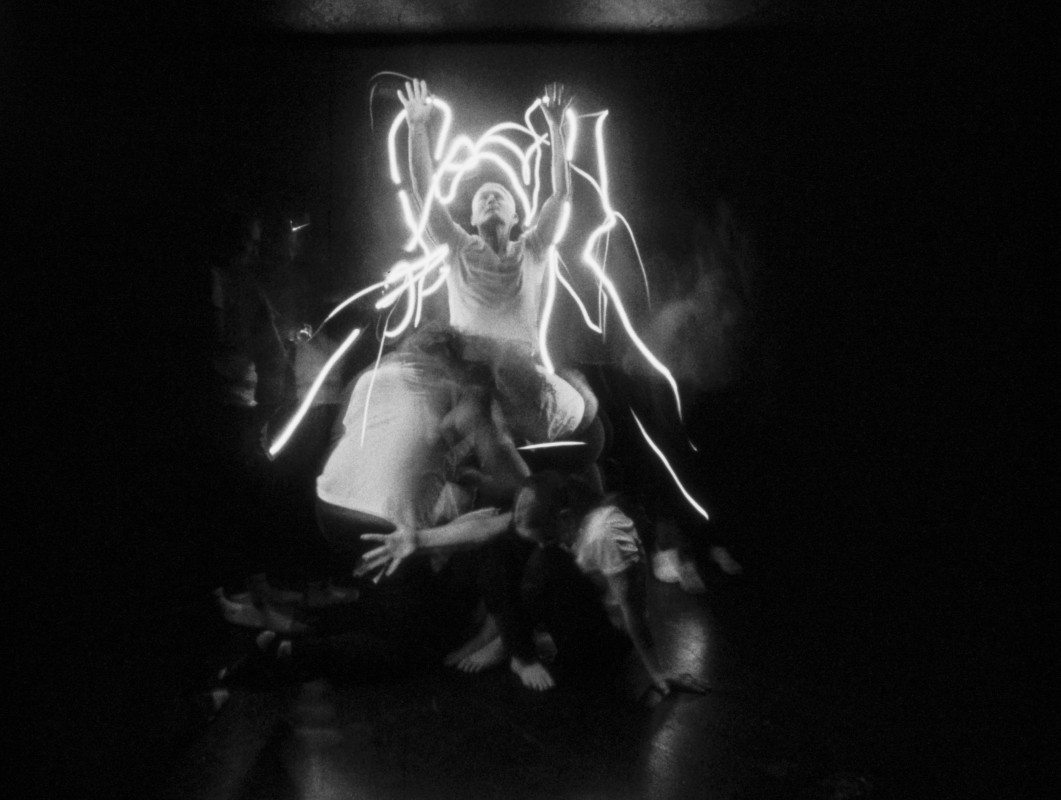
A young woman walks in front of a crowd, pumping her arms vigorously. Crowds of people merge with one another and retreat in eerie and yet somehow disjointed motion. A single person multiplies into a crowd, and a crowd slowly diminishes into a few individuals.
The viewing audience — Binghamton University lecturer Andrew Horowitz’s dance class — huddled around a spinning wheel, where they watched the images unfold within. Known as a zoetrope, the device created an early form of animation, each slat in its revolving side functioning like the fall of a shutter.
“It’s one of the earliest forms of animation. It predates photography,” said Horowitz, an artist-in-residence in Binghamton’s theater program. “After we learned how to do it, we started to make a series of animated films.”
Horowitz’s dance class is collaborating with Cinema Professor Ariana Gerstein’s animation class, Associate Professor of Cinema Monteith McCollum’s class in performative processes and Associate Professor of Music Daniel Thomas Davis’ graduate students in composition on a First Friday performance, to be held May 5 at Spool Contemporary Art Space in Johnson City. The project celebrates the 100th anniversary of the French film Ballet Mécanique, a masterpiece in early experimental filmmaking that brought together the work of painter Fernand Leger, filmmaker Dudley Murphy, photographer Man Ray, poet Ezra Pound and composer George Antheil.
Like the original Dadaist production, the project itself continues to unfold in unexpected ways. Gerstein’s class is sharing ideas and images with Horowitz’ students and will be projecting films they created during the dance event. They’re also working on various installations.
“We are experimenting with ideas of animation and technology, ranging from proto-cinematic devices, basic animation concepts, to approaches impacted by coding and artificial intelligence,” Gerstein said.
The composition class will write and record music, which will accompany video and animations shown on screens. The performative processes class is working on live sound accompaniment for Ballet Mécanique as well as animations created by Gerstein’s class. These live, improvised soundscapes will include electronic sampling, with potentially some zithers thrown into the mix as they move between melodies and rhythms, McCollum said.
“Being a part of something like this is just a great opportunity,” said Zoë Martinetti, a sophomore psychology major in Horowitz’s class. “It’s sort of a trial-and-error process; we work together and bounce ideas off each other.”
To create a zoetrope strip, motion must be disassembled and captured frame-by-frame.
Dancing frame by frame
“We’re pausing every five seconds while we’re creating constant motion. It’s a different way of thinking about it,” explained Jack Otero, a junior economics major in Horowitz’s class.
Take the film “Sarah Walking,” for example. The protagonist is actually standing still, and each frame is a separate photograph with subtle differences: a crowd of people shifting slowly to one side, a different arm position. In another, a conveyor belt of students winds across the floor, a classic move in early animation. A variation: the same conveyor belt shifts through theater seats, with the line changing subtly from frame to frame.
“All that has to happen is the lead person simply decides where he or she wants to sit next, and everybody else takes the seat that was previously occupied in front of them. In that way, we can keep it going like a snake,” Horowitz said.
Watching previous animations they made, Horowitz’s class pondered the possibilities: Perhaps the snaking line could form different geometric shapes or someone in the line can wear a red shirt, disappearing or appearing in various places. Perhaps they could play a sort of Tetris.
They decided on a sequence of moving shapes, which the students formed with their bodies on the dance room floor. As Horowitz captured each image with a cellphone on a tripod, the dancers curled into expanding circles, artfully positioned by their classmates.
In another sequence, Otero slowly moved from one awkward position to another, lifting head and leg, rolling on his side. The process of capturing the images resembled a dance strangely slowed and fragmented, a kind of animation-in-reverse.
“Bend your knees more, move your arm back and put your head down. Hold,” Horowitz instructed. “Raise your chin and look at me. Now move your whole body about 5 inches.”
Overall, the project has been stretching students’ creative horizons, providing different perspectives on what constitutes dance, animation or music. It’s also resulted in some productive collaborative moments between the classes.
Creating soundscapes
The animation students captured the dancers in Horowitz’s class both digitally and on film, which they then edited in fun and interesting ways, from AI-generated animation to rotoscoping, explained Kate Kitchin, a sophomore double majoring in cinema and comparative literature, and part of both the animation and performative processes class.
During one session, the animators met with the dancers in the Chamber Hall and played sound compositions created by McCollum’s class, which the dancers then interpreted through movement. In the darkened hall, the dance students also moved incrementally — as they did when creating the zoetrope strips — while lit by the flashlights on their peers’ cellphones. The animation students captured the images on 16 mm film with a Bolex movie camera that allows for single frames to be exposed over long durations, Gerstein said.
Prior to the animation class, junior graphic design major Fiona Sullivan had never used a camera for filmmaking. During the project, she learned to use both Black Magic Cinema and 16 mm film cameras, and gained deeper insight into the process of filmmaking.
“Paying homage to a film created 100 years before today has allowed the class members to step outside their comfort zones and work with many traditional and up-and-coming animation techniques that you usually wouldn’t be taught in class,” Sullivan said. “I really like the experimentation I get to have with animation as a medium for expression; it has allowed me to be more abstract with my work while still staying on theme.”
Together, the Performative Processes students have been watching the original Ballet Mécanique without sound and creating their own spontaneous accompaniment or live improvisation. Working in four small groups, they have also been recording sound samples and assembling them into compositions to accompany assigned pieces of the film, explained sophomore cinema major Sage Galati.
The project is also a lesson in teamwork, Galati said.
“I’ve worked on group projects before, but they were usually just with three or four people,” she said. “This project has us working with multiple different classes with numerous students.”
Leif Haley, a senior majoring in music and psychology, is part of both the composition and performative processes classes. For the former, he has composed a piece for the percussion ensemble — which he’s also part of — focusing on rhythm and machinery, inspired by the original Ballet Mécanique. The ensemble will record the piece, which may ultimately accompany choreography by the dance students.
“It’s still in its early stages, but as we get closer to the performance I think the collaboration between so many groups and departments will become clear, resolving into hopefully a great showcase of the film’s centennial,” Haley said.
As a musician, Haley found free improv to be a valuable experience, both alone and in groups.
“The more experience I get with electronic music, sound manipulation, sound synthesis and prerecorded sound, the better,” he said. “You can easily find yourself in a tangle of cables, plug-ins, audio equipment — not to mention different ideas and avenues of musical and sonic exploration — and sorting through all this to transform it into a single performance will be very interesting.”
The themes of the original Ballet Mécanique are even more relevant today: the rise of new technologies, and how they may transform both art and everyday life, reflected Christopher Golub, a senior double-majoring in cinema and philosophy and part of the animation class. Like the original film, the students’ projects are not intended to be didactic, but instead explore the meaning of the relationship between technology and humanity.
“It is the perfect time to be creating a new Ballet Mécanique, and Binghamton is a great locus for this to take place,” he said.

